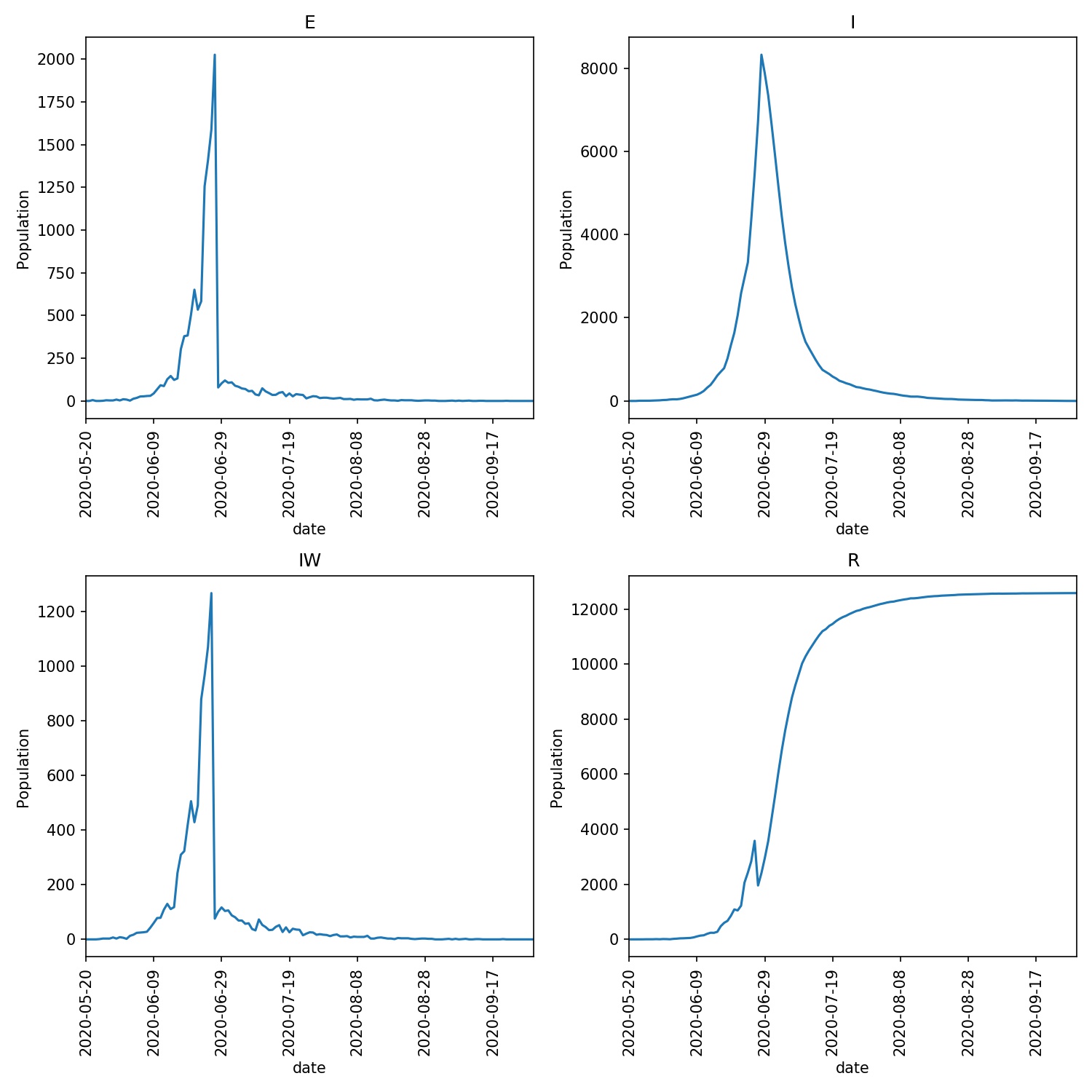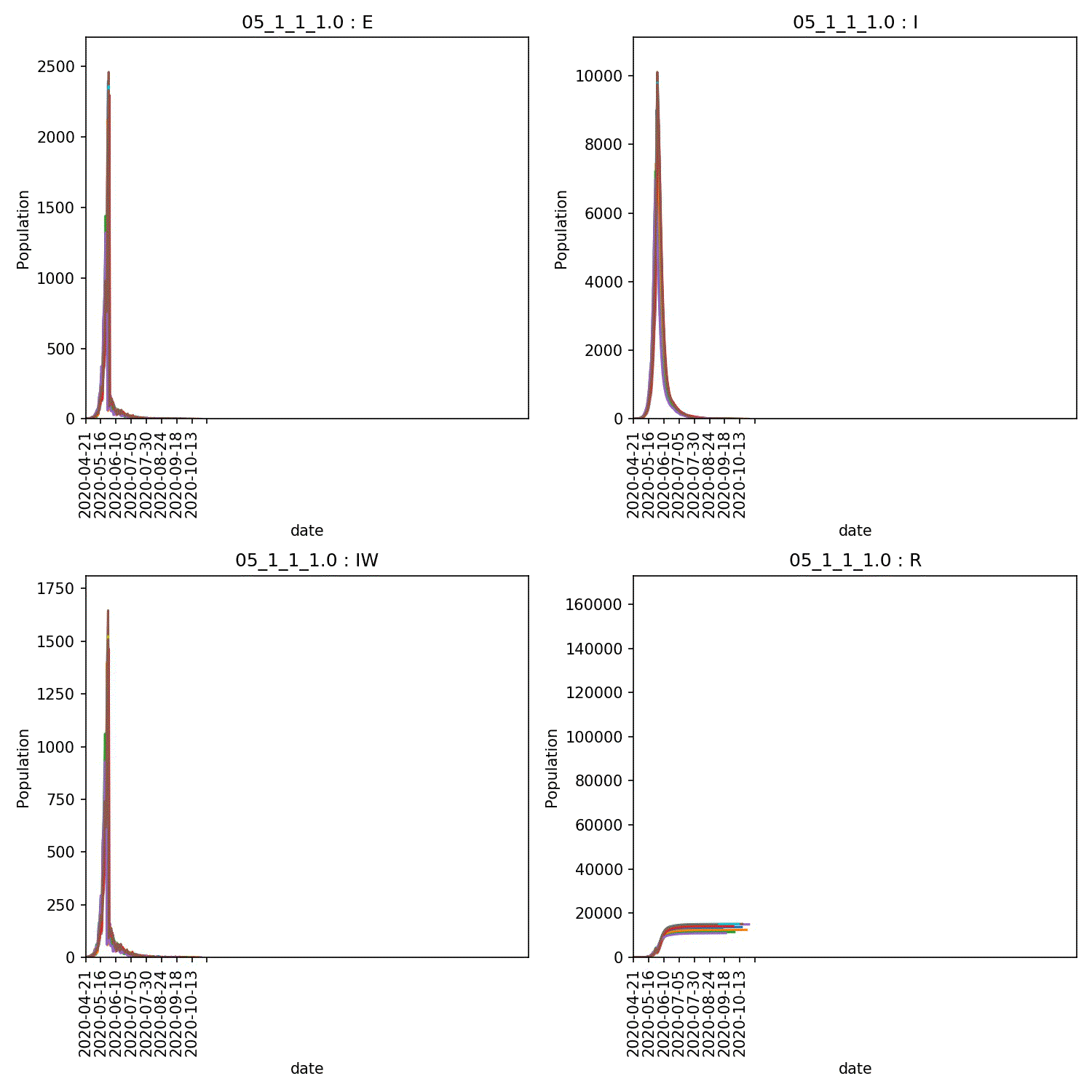Scanning lockdown
Now that we can create and scan custom variables, we can write a proper lockdown iterator that enables us to explore different scenarios.
Create a file called lockdown.inp and copy in the below;
# Full lockdown (red)
.scale_rate[0] = 0.05
.can_work[0] = False
# Relaxed lockdown (yellow)
.scale_rate[1] = 0.1
.can_work[1] = False
# More relaxed lockdown (green)
.scale_rate[2] = 0.1
.can_work[2] = True
This has defined three lockdown states, ranging from “red” (full lockdown with strong reduction in transmission rate and working) to “green” (relaxed lockdown with weaker reduction in transmission rate and work allowed).
To use this data create an iterator in a file called lockdown.py and
copy in the below;
from metawards.iterators import advance_infprob, advance_fixed, \
advance_play, iterate_working_week
from metawards.utils import Console
def get_lockdown_state(population):
if not hasattr(population, "lockdown_state"):
population.lockdown_state = -1
population.is_locked_down = False
if population.total > 5000:
if population.lockdown_state == -1:
Console.print(f"Lockdown started on {population.date}")
population.lockdown_state = 0
population.is_locked_down = True
elif population.lockdown_state > 0:
Console.print(f"Restarting lockdown on {population.date}")
population.lockdown_state = 0
population.is_locked_down = True
elif population.total > 3000:
if population.lockdown_state == 2:
Console.print(f"Re-entering relaxed (yellow) on {population.date}")
population.lockdown_state = 1
elif population.total < 2000:
if population.lockdown_state == 0:
Console.print(f"Entering relaxed (yellow) on {population.date}")
population.lockdown_state = 1
elif population.total < 1000:
if population.lockdown_state == 1:
Console.print(f"Entering relaxed (green) on {population.date}")
population.lockdown_state = 2
return population.lockdown_state
def advance_lockdown(network, population, **kwargs):
params = network.params
state = get_lockdown_state(population)
scale_rate = params.user_params["scale_rate"][state]
can_work = params.user_params["can_work"][state]
Console.debug("State", variables=[scale_rate, can_work])
advance_infprob(scale_rate=scale_rate,
network=network, population=population,
**kwargs)
advance_play(network=network, population=population,
**kwargs)
if can_work:
advance_fixed(network=network, population=population,
**kwargs)
def iterate_custom(network, population, **kwargs):
params = network.params
state = get_lockdown_state(population)
if population.is_locked_down:
Console.debug("Locked down")
return [advance_lockdown]
else:
Console.debug("Normal working week day")
return iterate_working_week(network=network,
population=population,
**kwargs)
The get_lockdown_state function is the most complex and different.
It uses the number of infecteds (population.total) to decide which
lockdown_state should be used. This is an integer, with -1
meaning no lockdown, 0 being “red”, 1 “yellow” and 2 “green”.
Whether or not the population is locked down is stored in the
population.is_locked_down variable. If this is “False” then
iterate_lockdown simply returns the result of
iterate_working_week(). Otherwise,
it returns the advance_lockdown function that we’ve defined.
This advance_lockdown function obtains the scale_rate and
can_work custom user parameters from the
Parameters objects in the model
Network.
It calls advance_infprob() with
the set scale_rate scaling factor, before calling
advance_play(), and then, if
can_work is “True”, advance_fixed().
Run metawards using the below commands and see what you get;
metawards -d lurgy3 -a ExtraSeedsLondon.dat -u lockdown.inp --iterator lockdown --debug
metawards-plot -i output/results.csv.bz2
I see;
━━━━━━━━━━━━━━━━━━━━━━━━━━━━━━━━━━━━━━━━━ Day 36 ━━━━━━━━━━━━━━━━━━━━━━━━━━━━━━━━━━━━━━━━━
Normal working week day lockdown.py:63
S: 56070689 E: 1663 I: 5889 R: 3836 IW: 1352 POPULATION: 56082077
Number of infections: 7552
━━━━━━━━━━━━━━━━━━━━━━━━━━━━━━━━━━━━━━━━━ Day 37 ━━━━━━━━━━━━━━━━━━━━━━━━━━━━━━━━━━━━━━━━━
Lockdown started on 2020-06-26
Locked down lockdown.py:60
State lockdown.py:43
Name │ Value
════════════╪═══════
scale_rate │ 0.05
can_work │ False
S: 56070608 E: 2118 I: 7192 R: 2159 IW: 80 POPULATION: 56082077
Number of infections: 9310
...
━━━━━━━━━━━━━━━━━━━━━━━━━━━━━━━━━━━━━━━━━ Day 51 ━━━━━━━━━━━━━━━━━━━━━━━━━━━━━━━━━━━━━━━━━
Entering relaxed (yellow) on 2020-07-10
Locked down lockdown.py:60
State lockdown.py:43
Name │ Value
════════════╪═══════
scale_rate │ 0.1
can_work │ False
S: 56069562 E: 36 I: 1518 R: 10961 IW: 55 POPULATION: 56082077
Number of infections: 1554
...
━━━━━━━━━━━━━━━━━━━━━━━━━━━━━━━━━━━━━━━━━ Day 55 ━━━━━━━━━━━━━━━━━━━━━━━━━━━━━━━━━━━━━━━━━
Entering relaxed (green) on 2020-07-14
Locked down lockdown.py:60
State lockdown.py:43
Name │ Value
════════════╪═══════
scale_rate │ 0.1
can_work │ True
S: 56069369 E: 46 I: 852 R: 11810 IW: 59 POPULATION: 56082077
Number of infections: 898
...
━━━━━━━━━━━━━━━━━━━━━━━━━━━━━━━━━━━━━━━━ Day 187 ━━━━━━━━━━━━━━━━━━━━━━━━━━━━━━━━━━━━━━━━━
Locked down lockdown.py:60
State lockdown.py:43
Name │ Value
════════════╪═══════
scale_rate │ 0.1
can_work │ True
S: 56068649 E: 0 I: 0 R: 13428 IW: 0 POPULATION: 56082077
Number of infections: 0
Infection died ... Ending on day 188
with the overview graph as here;

Running on a cluster
Now that this is working, we can scan through lots of different lockdown
scenarios by creating an input file that varies the scale_rate and
can_work parameters. Create an input file called scan.csv and
copy in the following;
# Adjust "red" state from 0.05 to 0.20
# while adjusting "yellow" from "green" + 0.05 to 0.25
# while adjusting "green" from "yellow" if working, or
# "yellow" + 0.05 if not
.scale_rate[0] .scale_rate[1] .scale_rate[2] .can_work[2]
# first set allow working in "green"
0.05 0.10 0.10 True
0.05 0.15 0.15 True
0.05 0.20 0.20 True
0.05 0.25 0.25 True
0.10 0.15 0.15 True
0.10 0.20 0.20 True
0.10 0.25 0.25 True
0.15 0.20 0.20 True
0.15 0.25 0.25 True
0.20 0.25 0.25 True
# second set prevent working in "green"
0.05 0.10 0.15 False
0.05 0.15 0.20 False
0.05 0.20 0.25 False
0.05 0.25 0.30 False
0.10 0.15 0.20 False
0.10 0.20 0.25 False
0.10 0.25 0.30 False
0.15 0.20 0.25 False
0.15 0.25 0.30 False
0.20 0.25 0.30 False
Note
Note that we have added comments to this file using ‘#’ - these are useful to help your future self understand what you were doing
Copy all of the files onto a cluster and submit the job where you repeat each adjustable variable set 16 times. I used the PBS job script;
#!/bin/bash
#PBS -l walltime=12:00:00
#PBS -l select=4:ncpus=64:mem=64GB
# The above sets 4 nodes with 64 cores each
# source the version of metawards we want to use
source $HOME/envs/metawards-0.8.0/bin/activate
# change into the directory from which this job was submitted
cd $PBS_O_WORKDIR
metawards --additional ExtraSeedsLondon.dat \
--disease lurgy3 -u lockdown.inp \
--iterator lockdown \
--input scan.csv --repeats 16 --nthreads 8 \
--force-overwrite-output
Submit your job (e.g. qsub jobscript.sh) and then wait for it to
finish. Once it has completed, generate the overview and average
graphs via;
metawards-plot -i output/results.csv.bz2
metawards-plot --animate output/overview*.jpg
metawards-plot --animate output/average*.jpg
What do you see?
I get a range of scenarios, from outbreaks that are controlled until they die out, through oscillating outbreaks where the population is forever moved between the “green” and “yellow” lockdown states, through to outbreaks that grow despite lockdown. These can all be seen here;
